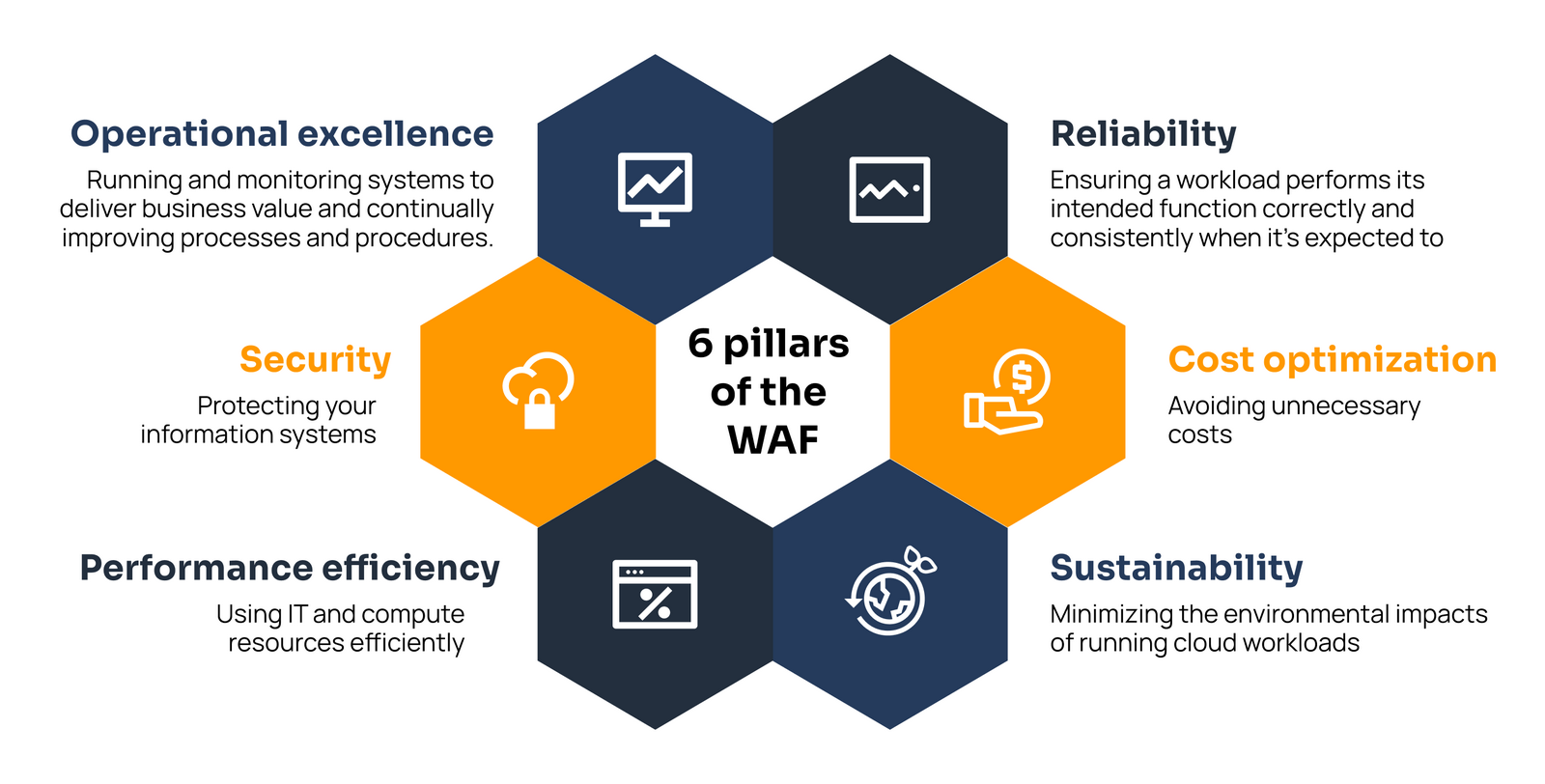As a cloud-friendly business, AWS offers you such a wide range tools that even experienced engineers and architects might not realise the full extent of early decisions and choices until a project or solution is well underway. Costs might start to spiral from a commitment to a particular set of functions, or certain unanticipated events might start to derail and overwhelm your workload. From a positive perspective, you might want to save money by optimizing usage of resources, reach sustainability goals or need to comply with local laws about sustainability.
As with any widely used system or technology, the likelihood is that you’re far from alone in having experienced such issues and, thanks to the well-established and extensive user base, AWS is no exception. Not only that but, drawing on their deep experience, AWS has actively sought to encode this body of knowledge in the form of the Well-Architected Framework.

According to AWS, “The Well-Architected Framework is the customer-facing implementation of our internal review process, where we have codified our principal engineering thinking across field roles, like Solutions Architecture and internal engineering teams. The Well-Architected Framework is a scalable mechanism that lets you take advantage of these learnings.”
What this means in practice is that the AWS Well-Architected Framework is there to help you understand the pros and cons of decisions you make while building systems on AWS. Using the Framework helps you learn architectural best practices for designing and operating secure, reliable, efficient, cost-effective, and sustainable workloads in the AWS Cloud. It provides a way for you to consistently measure your architectures against best practices and identify areas for improvement.
What is cloud architecture?
Before we continue, it might be worth considering what we mean exactly when we talk about “cloud architecture”. In simple and practical terms, cloud architecture is the design of a system that uses cloud computing to deliver services. It typically involves multiple components, including hardware, software, networking and storage. As a system, it must be designed to meet the needs of an organization in terms of its size, workloads and applications and should also be able to scale up or down as needed.

General Design Principles
With this understood, the Well-Architected Framework identifies a set of general design principles to facilitate good design in the cloud such as: “Test systems at production scale”, “Automate to make architectural experimentation easier” and “Drive architectures using data”. However, at this stage it’s very difficult to start to talk about “good” and “bad” architectures without first establishing some sort of context. After all, there are almost endless ways to build a system and every choice has a consequence that may or may not be desirable depending on what you want it to do. This is where the 6 pillars of the AWS Well-Architected Framework come in.
The 6 Pillars and the Well-Architected Review.
The six pillars are six fundamental aspects of a well-architected cloud system: Operational excellence, Security, Reliability, Performance efficiency, Cost optimization and Sustainability.

Based on these six categories, AWS engineers have developed a sequence of questions for each pillar that an organisation can ask itself in order to be able to evaluate and refine their cloud architecture. These questions form the basis of the AWS Well-Architected Review, which is a process designed to help you evaluate and improve your architecture. It consists of two parts:
- The Self-Assessment, which you can complete on your own or with the help of an AWS Partner; and
- The Review itself, which should be conducted by an AWS Certified Solutions Architect.
The Self-Assessment is essentially a questionnaire that covers six key areas mentioned above. Each area has its own set of questions that will help you to identify potential issues and recommend solutions.
Once you’ve completed the Self-Assessment, you’ll have a meeting with an AWS Solutions Architect to conduct the Review itself. This involves going over your answers to the questionnaire in detail and discussing how well your architecture meets each of the six pillars. The goal is not only to identify potential improvements but also to share best practices so that you can continue to optimize your architecture in the future.
High-Risk Issues
It's important and interesting to note that AWS stress that the review of architectures “needs to be done in a consistent manner, with a blame-free approach that encourages diving deep. It should be a lightweight process (hours not days) that is a conversation and not an audit.” As such, the emphasis here should be on identifying things that can be changed and improved, especially those with maximum impact and benefit to your business. These are typically referred to as High-Risk Issues (HRIs) and should be seen as ideal opportunities for getting the best results, often with the least effort and outlay in relation to the anticipated improvements.
What happens next?
Once the review is complete, you’ll have a set of recommendations for improving your architecture and you’ll need to create a plan for addressing them. Once you've implemented the proposed changes, it's important to re-run the well-architected review periodically to ensure that your architecture remains aligned with best practices.
The PCG solution
If you sign up for our AWS Well-Architected Review offer, we’ll first schedule a workshop to go through the review itself. After we review your environment together, our team will help you identify the HRIs and create a remediation plan. Finally, we'll work together with you to resolve the HRIs and identify the appropriate templates that will illuminate the road ahead. In some cases, this can take the form of a CDK template, while in others you might require a set of recommendations so that things like ITIL processes can be implemented further into your organisation.
Net Zero Cost
After remediating 45% of the identified HRIs, as an AWS Well-Architected Partner, we can apply for AWS funding of 5,000 USD in AWS credits. This essentially makes this offer a Net Zero cost for you, which can’t be a bad thing!
If you’d like to know more about the details and processes of the AWS Well-Architected Review, as well as our offer, visit our AWS Well-Architected Review service page.
Let us light your way to a better AWS environment.
Would you like to find out how the Well-Architected Framework can help streamline your processes, improve your cloud security and reduce your costs? Contact us to schedule a meeting today and let’s begin the conversation.
